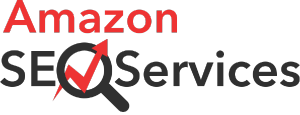Understanding Historical Data Analysis in Demand Forecasting
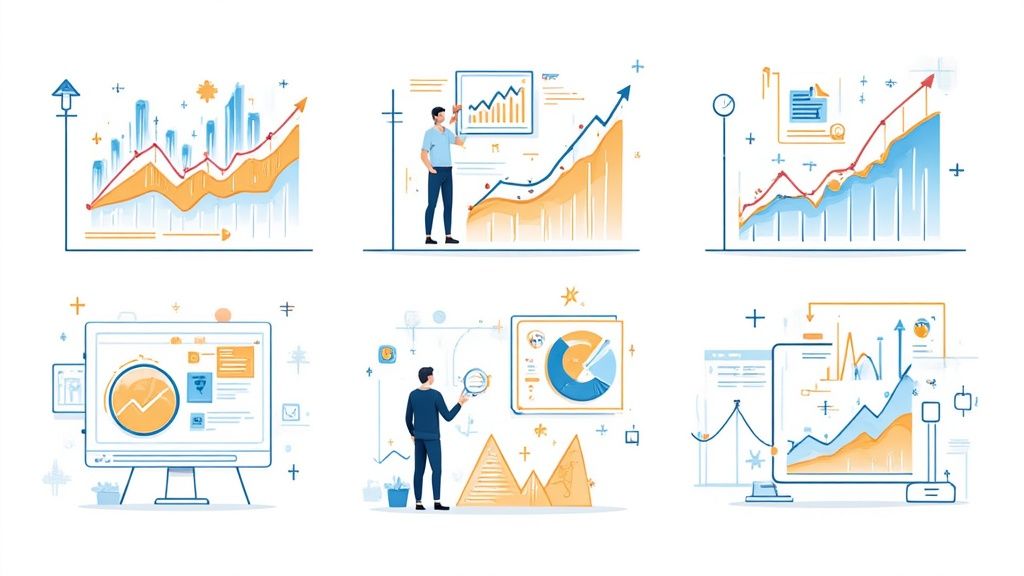
Effective demand forecasting helps businesses make smart decisions about inventory, staffing, and operations. At its core, this process relies on analyzing past data to spot trends and patterns that can predict future customer demand. Let’s explore how companies turn raw historical data into practical forecasting insights.
Identifying Critical Data Points
The first crucial step is choosing the right data to analyze. This includes obvious metrics like past sales figures and product returns, but also broader indicators like website traffic, marketing campaign results, and external factors such as economic trends or seasonal patterns. For example, an online retailer might track both sales data and site visits to understand conversion rates and predict demand based on expected traffic. Being selective about which factors truly impact demand helps create more accurate forecasts.
Data Cleaning Techniques for Enhanced Accuracy
Having good data is essential for reliable forecasts. This means carefully cleaning the data to fix errors, remove duplicates, and fill in missing information using proven statistical methods. Poor quality data leads to inaccurate predictions that can result in costly business mistakes. Taking time to verify and clean data may seem tedious but it’s vital for trustworthy forecasting.
Combining Traditional Analysis With Modern AI Tools
While classic statistical approaches still have value, many businesses now use AI and machine learning to enhance their forecasting. These tools can quickly process huge datasets and uncover hidden patterns that basic analysis might miss. The historical data method remains one of the most reliable approaches – it uses past sales data to predict future demand by identifying seasonal trends and patterns. Throughput provides more details on how AI tools complement traditional forecasting methods.
Avoiding Common Data Collection Mistakes
Several key mistakes can throw off forecast accuracy. These include focusing only on internal data while ignoring market conditions, inconsistent data collection over time, and failing to account for seasonal changes. For instance, a retailer looking solely at their own sales data might miss important shifts in customer preferences or competitive moves. Systematic data collection and validation processes help avoid these pitfalls and produce better forecasts.
Mastering Time Series Analysis for Accurate Predictions
Understanding past data patterns helps businesses make smarter decisions about future demand. By examining historical trends and cycles, companies can better prepare for what’s ahead. Time series analysis gives you a structured way to spot important patterns and use them to your advantage.
Understanding Key Time Series Components
When analyzing time series data, there are three main patterns to watch for:
- Trends: Long-term upward or downward movements (like growing sales over several years)
- Seasonality: Regular patterns that repeat at fixed intervals (like higher ice cream sales in summer)
- Cyclical Changes: Longer waves of variation tied to broader factors like economic cycles
Knowing how to spot these patterns helps create more reliable forecasts. For example, a clothing store can use seasonal data to stock winter coats at just the right time.
Exploring Effective Time Series Techniques
Two main approaches help turn historical data into future insights:
- Exponential Smoothing: Gives more weight to recent data points while still considering older patterns
- ARIMA Models: Look at relationships between data points to predict what comes next
These methods help businesses make both short-term and long-term forecasts. A retail store can analyze past holiday sales to prepare inventory levels that match customer demand without overstocking. Learn more about time series forecasting at Effective Software.
Choosing the Right Approach for Your Business
Pick your forecasting method based on:
- Your data patterns
- How far ahead you need to predict
- The accuracy level required
Simple approaches like exponential smoothing work well for stable, short-term forecasts. But when dealing with complex patterns or longer timeframes, more advanced models like ARIMA may be needed. The key is matching the method to your specific business needs.
Making Smart Predictions for New Products and Markets
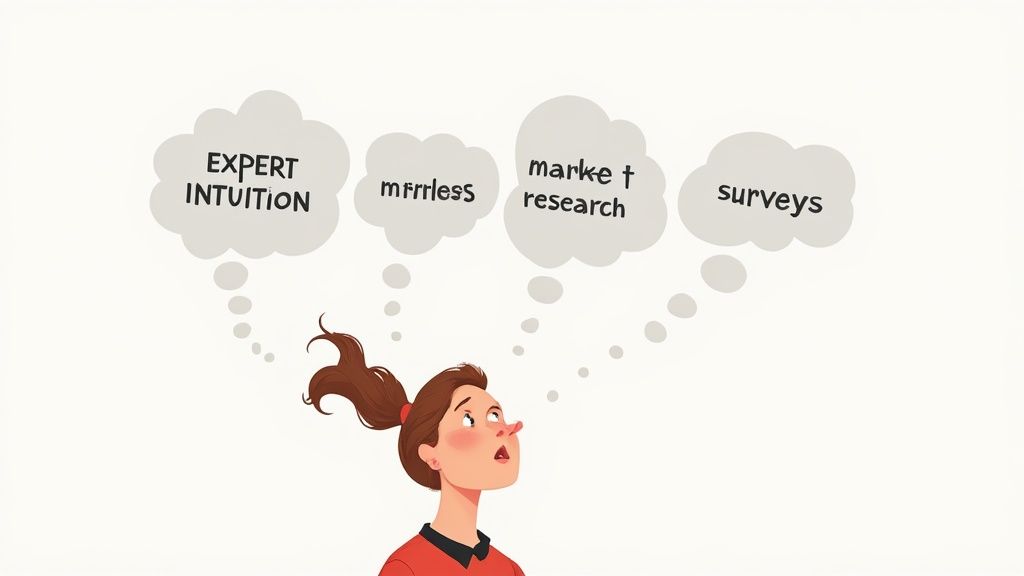
Past data is extremely valuable for forecasting, but it has limitations when predicting demand for new products or emerging markets. This is where qualitative forecasting methods become crucial. These approaches tap into expert knowledge and market understanding to make smart predictions even when hard data is limited.
Getting Expert Input
One key qualitative forecasting approach is gathering insights from experts. This could mean consulting internal team members who deeply understand the market or bringing in external specialists in that industry. For example, a company launching a new tech product might work with industry analysts to estimate adoption rates. Their expertise helps refine predictions and reduce risks.
Using Market Research and Customer Feedback
Market research and customer surveys provide essential qualitative insights. Through market research, companies can understand how consumers behave, what they prefer, and their buying habits. Direct customer feedback through surveys reveals valuable information about future purchase intent. These tools are especially helpful for new product launches since they show how the market might respond.
The value of qualitative methods shines when dealing with new products and markets where past data doesn’t exist. These approaches rely on expert judgment and informed opinions to gauge future demand. According to research, 87% of suppliers use forecast information directly from their customers. This shows just how important qualitative input is for accurate predictions. Learn more about these statistics here.
Blending Different Data Types
While qualitative methods work well when historical data is scarce, the best forecasting usually combines both qualitative and quantitative information. This means pairing expert opinions and market research with any available numbers, like early sales data or pilot program results. Using both types of data provides deeper insights into what drives demand and leads to more accurate forecasts. For instance, combining initial sales figures with expert views on market growth potential creates a more complete prediction.
Building an Integrated Multi-Method Forecasting Strategy
Getting demand predictions right often means using multiple forecasting methods together. When combined thoughtfully, different approaches complement each other’s strengths to give more reliable results. Let’s explore how mixing methods lead to better forecasting.
Combining Forecasting Methods for Increased Accuracy
Using multiple forecasting methods together helps companies make better predictions. For example, looking at past data shows long-term patterns, while analyzing recent trends catches short-term changes. Adding expert opinions and customer feedback provides important context that raw data misses. This multi-angle view paints a clearer picture of future demand.
Balancing Different Forecasting Inputs
Success with multiple methods requires careful weighting of each input. Every approach has its strengths and limitations. A business might rely more on recent trends for next month’s forecast while giving more weight to historical patterns and market research for long-term planning. The key is knowing which methods work best for different timeframes and situations.
Managing Conflicting Predictions and Creating Feedback Loops
Sometimes different forecasting methods will point to different outcomes. Working through these conflicts means carefully examining why each method arrived at its conclusion. Having a clear process to evaluate and resolve differences is essential. Regular comparison of forecasts against actual results lets companies spot areas for improvement. This ongoing review helps refine and strengthen forecasting over time.
Frameworks for Weighing Different Methods
Companies can use structured approaches to determine how much weight to give each forecasting method. Important factors include data quality, forecast timeline, and product characteristics. For new products with limited history, expert judgment may get more emphasis. For established products with years of data, statistical analysis often leads. Finding the right mix for each situation improves accuracy.
Real-World Success Stories
Many companies have found success by blending forecasting methods. Take retailers forecasting seasonal items – they often combine sales data analysis with store manager feedback for more accurate predictions. Adding local insights helps them better match inventory to each store’s unique needs. These examples show how combining methods delivers practical benefits and better results.
Implementing Advanced Analytics and AI in Your Forecasting Process
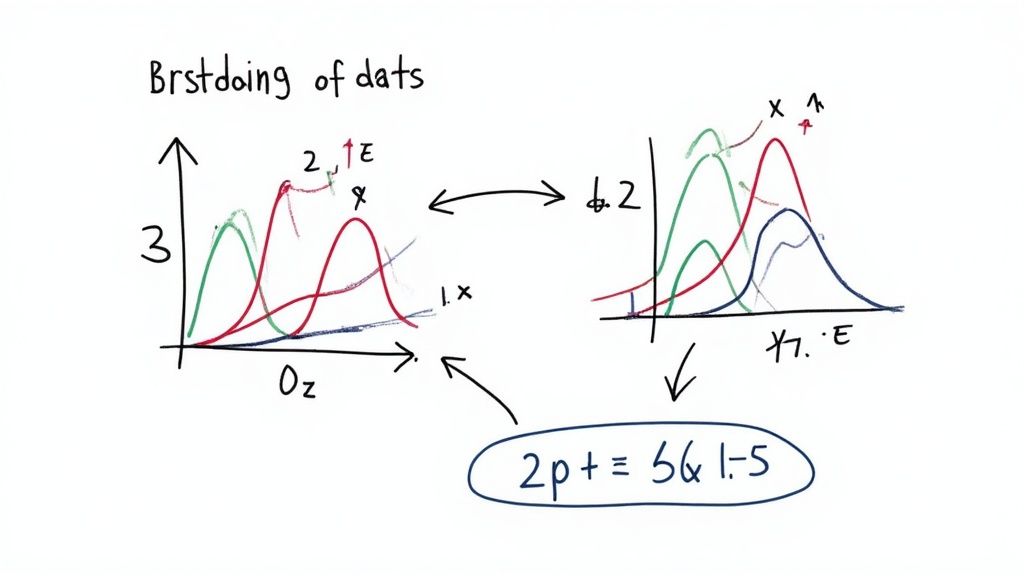
A strong understanding of demand forecasting methods opens the door to making your process even better through analytics and AI. By using these tools effectively, you can significantly improve your forecasting accuracy and make smarter decisions about your Amazon business.
Using AI to Improve Your Forecasting
AI is making a real difference in how businesses predict future demand. Tools like machine learning and predictive analytics help companies spot patterns and trends that would be impossible to see otherwise. When used well, these tools help businesses make quick, data-backed decisions to stay ahead of market changes.
Finding the Right AI Tools
The best AI solution for your business depends on your specific needs. Small businesses often do well with simple, cloud-based forecasting tools, while larger companies might need custom solutions that work with their current systems. Take time to evaluate your options based on your business goals and resources.
Getting Started with Implementation
When adding AI to your forecasting process, focus on these key areas:
- Data Protection: Make sure your AI tools keep your business data safe and follow all required regulations
- Working with Current Systems: Your AI tools should connect smoothly with the software you already use
- Staff Training: Help your team learn to use the new tools effectively – good training leads to better results
Combining AI with Human Knowledge
Think of AI as a powerful assistant, not replacing your team’s expertise. While AI crunches numbers and spots patterns, your team provides crucial context and judgment. This partnership between AI insights and human experience leads to better forecasting decisions.
Creating Your Technology Foundation
Build a complete system that supports accurate forecasting. Connect your AI tools with your inventory tracking and business reporting software for smooth data flow and better teamwork. You’ll make smarter decisions based on solid data with the right setup. For Amazon sellers, this means better product listings, smarter ad spending, and increased sales. eStore Factory helps sellers achieve these goals with proven methods and support.
Measuring and Optimizing Forecast Performance
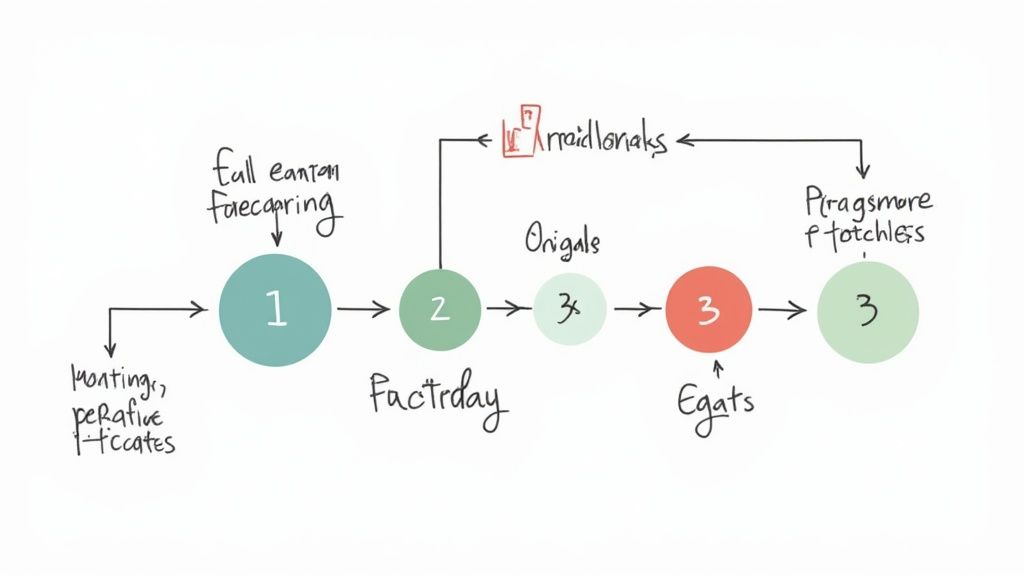
Great demand forecasting is only step one. The real work comes from consistently measuring results and fine-tuning your approach. Success requires tracking the right metrics, understanding where things go wrong, and building a system for steady improvement.
Establishing Meaningful KPIs
The first task is picking metrics that truly matter for your business. Common measurements include Mean Absolute Percentage Error (MAPE), Mean Absolute Deviation (MAD), and Weighted Mean Absolute Percentage Error (WMAPE). Each one tells you something different about how accurate your forecasts are. WMAPE works especially well for products with big differences in sales volume since it puts more weight on your high-selling items. The key is choosing metrics that match your specific goals and product mix.
Implementing Effective Error Tracking Systems
Just measuring isn’t enough – you need a clear system to spot and analyze what’s going wrong. This means finding the root causes of mistakes, whether they come from bad data, wrong assumptions, or outside factors you didn’t see coming. For instance, if customers suddenly change their buying habits, your forecasts might be way off. Looking closely at these errors helps you find weak spots and fix them.
Creating Continuous Improvement Cycles
Getting better at forecasting never really ends. Smart companies set up feedback loops where they constantly compare what they predicted to what happened. This helps catch patterns in their mistakes. Regular checks and adjustments keep forecasts on target as markets change. If you keep predicting too much demand for certain items, it’s time to look at the data and think behind those forecasts.
Building a Culture of Continuous Improvement
The whole team needs to be on board with making forecasts better over time. Get your sales, marketing, and operations teams talking and sharing what they know. When everyone contributes their insights, your forecasting gets sharper and more accurate. Different viewpoints lead to better predictions.
For Amazon sellers looking to boost their forecasting and overall results, consider working with eStore Factory. Learn more about how eStore Factory can help optimize your Amazon business.
